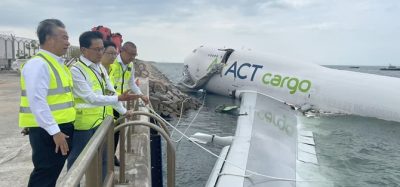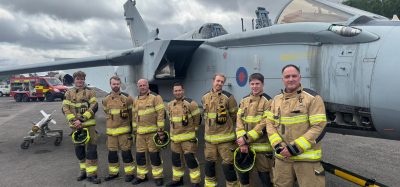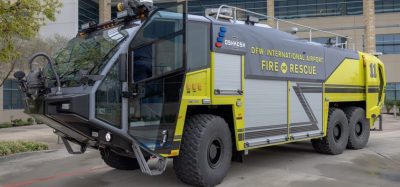Training and readiness is crucial for the fire and rescue staff at your airport
Posted: 22 February 2010 | Jens-Peter Larsen, Fire Chief, Copenhagen Airport, Denmark | 3 comments
Daily routines, training, readiness (the effort of being constantly ready) – are not new words when we are setting demands for our fire and rescue personnel. This article will give some examples in “lessons learned” from aircraft disasters, in order to give value to the words ‘daily routines’, ‘training and readiness”, and how to use the knowledge in a proactive way.
Daily routines, training, readiness (the effort of being constantly ready) – are not new words when we are setting demands for our fire and rescue personnel. This article will give some examples in “lessons learned” from aircraft disasters, in order to give value to the words ‘daily routines’, ‘training and readiness”, and how to use the knowledge in a proactive way.
But first – why this article? ‘Sharing knowledge’ are the key words, because it is very seldom that we in airport fire and rescue actually face a real aircraft accident. On the other hand, there are a lot of expectations with regard to our performance in fire and rescue. Your airport, the airlines, the crew, passengers and everybody from the outside world has this feeling and expects the fire and rescue to know what they are doing in order to save lives.
So both the basic training, coupled with all of the small details, can together make the fire department in your airport a unit that can be counted on when the big thing occurs.
‘Lessons learned’ are key words here and one way of improving is to share your experiences and to collect all kinds of information from other airport fire fighters around the world.
I have had the good fortune to be a delegate and speaker at a number of conferences arranged by airport fire fighting organisations, but also as a guest lecturer at Singapore Aviation Academy (SAA). I have met a number of true professionals, who all have real passion for the Aircraft Rescue and Fire Fighting (ARFF) industry.
At Copenhagen Airport fire and rescue we have made a lot of changes over the last ten years. First in training improvements, then in upgrading our fleet and equipment. We got a big “eye opener” back in 2001.
The story I: In 2001, a disaster occurred at Linate Airport, Italy, where an MD 80, during rotation, collided with a Cessna killing all on board both aircraft. Copenhagen Airport later invited firemen and incident commanders from Italy to come to Copenhagen to tell their stories. That, somehow, has changed our attitudes in many aspects. The physical performance needed during a 36 hour incident, the mental influence, how to make a quick refill at our trucks and the forcible entrance, was the first lesson learned after talking to the Italians.
Two minutes after the alarm, the first fire trucks arrived, to what you easily can describe as a “worst case scenario”. The Md 80 has skidded off the runway and after 450 metres it hit a building at a speed of 257 km/hour – killing all on board instantly. The plane and part of the building was on fire completely when the fire and rescue arrived. So now, the Italians were in full power roof monitor operation and it took them 20 minutes to complete the first line response.
Refill your fire trucks, forcible entry’s, the psychical challenge
Of course we will have to refill after a roof monitor attack, as the water tank will empty after just three minutes. Many airport fire brigades have various systems and equipment to make a quick refill and many use a high level water tank facility (very often located near one of the fire stations), so that the water simply dumps into the fire truck. It is very rapid in itself but we have to add in to this procedure the driving distance from the place of the accident and back to this facility. In Linate, it was two minutes in driving distance – then back again. So that is a minimum of 7-8 minutes to refill.
In Copenhagen Airport we have a lot of hydrants inside the airport fence and we have tested that we can refill a fire truck with 12.000 Litres of water in 5.17 minutes. What we learned from Linate was to be familiar with our own refill procedures and get a feeling for the time needed.
Forcible entry’s are difficult and the best tools are needed. In Linate they only have three rescue saws with traditional multi blades and with a limited diameter. What you actually need is a big rescue saw with a 16 inch diamond blade as a minimum. You also need to have a lot of practice.
The psychical challenge was at its highest level in Linate on that morning. It took alot of manpower and shows very clearly that an airport fire fighter must be in good shape – he therefore has to do his time in the gymnasium. At the time, back in 2001, we did not have a psychical programme for our fire fighters in Copenhagen Airport – many of them did however participate in sports in their spare time. We soon realised that we had to do better, so a different kind of compulsory psychical programme was introduced, including a spinning programme.
The Linate accident was therefore a “lesson learned part I” for us in Copenhagen and at the moment we are in the middle of “part II”.
The story II: Well, in the years after Linate we kept on evolving and the annual conferences arranged by Aircraft Rescue Fire Fighting Working Group (ARFFWG) and Interational Aviation Fire Protection Association (IAFPA) are perfect occasions to learn and get new ideas. Our visit to Singapore Aviation Academy (SAA) has been another eye opener for our department.
A conference in Toronto taught us what ‘Hot Brakes’ is all about, SAA gave us new ideas to create annual physical tests and operational skills in handling our fire apparatus, and a conference in Las Vegas gave us value into our daily vehicle inspection and meaning to the word “readiness.”
Hot brakes, annual physical test, Fire Apparatus Operations Certificate, the daily inspection and readiness.
You can talk about two steps in how to deal with hot brakes on an aircraft. The first step is the increased braking temperature that you can handle with airflow around the gear assembly, for which fans are a fine solution. The second step is when the braking temperature is so high that smoke from the landing gear, hydraulic hoses and the brake discs are present. (That was a precise statement coming from the Boeing factory at the conference in Toronto) In step two, you go against all the myths. You simply use water to cool down the centre axle on the gear assembly – because if this axle gets damaged due to high temperature, it costs a lot of money and time to change the part. Saving value folks…
Our spinning programme went ahead and we began to get in good shape. An annual physical test was therefore the next natural element to be implemented.
With complete turn out gear on, including breathing apparatus, every fireman must:
- Walk a distance of 100 metres, carrying six fire hoses
- Pull 75 kg over a distance of 25 metres
- 25 strokes with a sledge hammer
- Walk up to the 4th floor
- Draw in a fire hose 15 metres up.
That is our annual test, quite simple and to date everybody has passed.
Fire Apparatus Operations Certificate – another important ball game. Over the years we have very often discussed the importance of every fireman’s capability to handle our fire trucks. At many airports, our trucks vary in manufacturer, age, technique and location of joysticks and buttons. As a fire chief, I truly believe that every member of the crew knows his vehicle and can do the basic operations – even during night time, heavy rain and in off road conditions.
After receiving three new Rosenbauer Panthers and together with the two Volvo fire trucks (also based on the Panther technology) we have now made a “Panther Certificate” for all fire fighters.
The daily vehicle inspection can easily be bettered and that was one of the statements at the ARFFWG conference in Las Vegas. Why don’t you simply combine the inspections with procedures? As with many fire departments, we have daily and weekly inspections on our fire equipment and in addition to the inspections, we now do line up procedures to different kind of aircraft – all in order to get familiar with distance, heights and aircraft knowledge in general. Quite simple and useful.
In what direction is your Airport fire and rescue headed?
Quote: “48 million passengers are counting on us and expect us to make the difference” said by the fire chief from Las Vegas airport, USA – and that is maybe a key statement of what it is all about. We don’t have a second chance to make it right – so apart from the normal training and daily routines, it is crucial that your entire management (crew chiefs, incident commanders, education officers, fire chief, airport managers) are able to motivate all fire fighters, and set new standards and goals.
Every year we adopt three easy words that support our focus areas.
In 2009 it is training, maintenance, and readiness that have become our words that are easy to remember.
Training – here we are talking back to basics. This year we will practice the line up procedures especially.
Maintenance – simply “wax on, wax off”, since our water is very calcareous.
Readiness – The three minute response time is clear to everybody, but do we pay enough attention to all aspects.
Conclusion and the next steps
“Lessons learned” are very important among Airport fire and rescue. Only by sharing experiences can we do better. In many places around the world, a lot of interesting progress has been made with regard to improving the aircraft rescue fire fighting industry. For example:
Rescue stair – since the Airbus 380 came into operation, there has been focus on the height and dimensions of the plane and especially how airport fire crews can make a quick and safe entrance to the plane. A rescue stair is very useful, even to index C aircraft.
HRET – high reach extended turret or “snozzle” has been on the market for some years and both the high reach and low attack features, together with the piercing device, give extra options and efficiency. In combination with an infrared camera, so that the detection of a cargo fire is possible, this is a great tool. The “snozzle” from Crash Rescue is now in the fifth generation and are made in 50 or 65 feet versions.
Rehealing foam – Many users of AFFF foam fluid know that it is very efficient, but also has some environmental problems because of the presence of flour. This very often gives our fire fighters limited possibilities to use it during practice. A new type of foam fluid “rehealing foam” can solve this problem, since it has already been tested according to Mil. Spec. Test.
CAFS – compressed air foam systems are now an option for your roof turret. Two advantages are; a better throw range even in op-wind directions, and a better foam quality for hanging into vertical surfaces.
Driving simulators – to avoid roll-overs, that can cost lives and the loss of expensive vehicles, Singapore Aviation Academy now has the most modern and highly technical driving simulator in the world. Fire fighters from Changi Airport can now receive lessons and try all kind of situations – driving around their airport in this very advanced simulator.
So the bottom line is that the ARFF industry and the community must work together, in order to create new ideas and new equipment. In order to get the right output we all need to share, to practice, to motivate, so that our fire fighters get the best options in saving lives and values.
About Copenhagen Airport
The biggest airport in Scandinavia with 21 million passengers and three runways. CPH has a great infrastructure, with train, metro and freeway in connection and also a bridge to the south part of Sweden. See also www.cph.dk
Fire and rescue have two fire stations and are a Kat. 9 / index E.
Join our free webinar: Transforming Airport Security – Innovation, Impact, and the Passenger Experience
The landscape of airport security is undergoing a profound transformation, driven by evolving threats, technology, and passenger expectations. This webinar focuses on how AtkinsRéalis has been transforming security processes at some of the world’s busiest airports with smarter, more adaptive solutions.
Date: 4 Nov | Time: 14:00 GMT
REGISTER NOW TO SECURE YOUR SPOT
Can’t attend live? No worries – register to receive the recording post-event.

















Dear Jens-Peter Larsen and Martin Howardsen,
Greetings from National Aviation University, Kyiv, Ukraine! I hope you are OK.
It has been a long period since we contact last time. I have had my doctor’s degree dissertation accepted by the Scientific Board for the defense.
The theme is about active transport systems operation in conditions of multi-alternativeness and uncertainty.
The dissertation and auto-abstract are available to download free at our University repository: http://er.nau.edu.ua:8080/handle/NAU/22359
You and your colleagues are welcome to visit and see if you and/or they are interested to.
Best regards,
Andy
My skype name: andygoncharenco
+380669550225
+380684417071
+380933382376
As an Aviation Rescue & Fire fighter in a young and small country (Papua New Guinea), such article motivates, educate and inspires me to be better at this job.
I really appreciate the experiences shared and resolutions recommended in this article which I shall surely apply at my ARFF station.
Thank you for the kind response Moses I am glad you found the article useful.